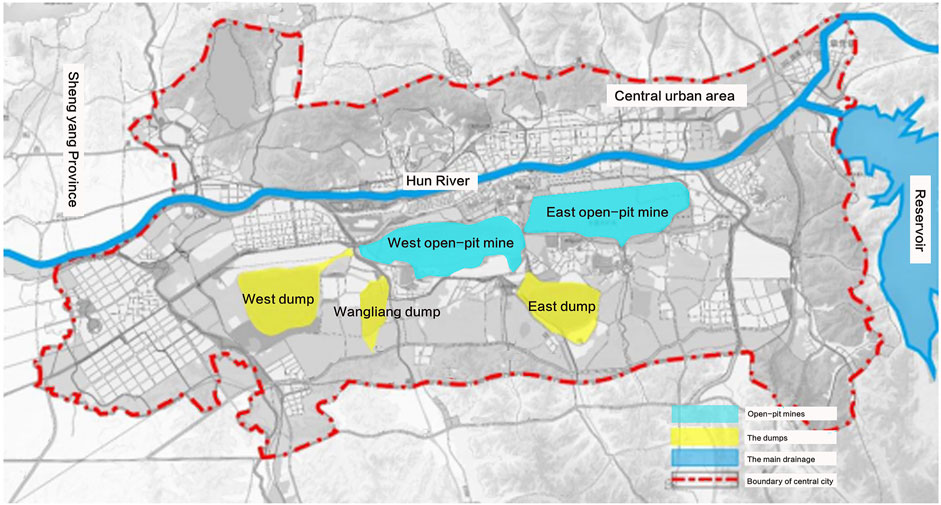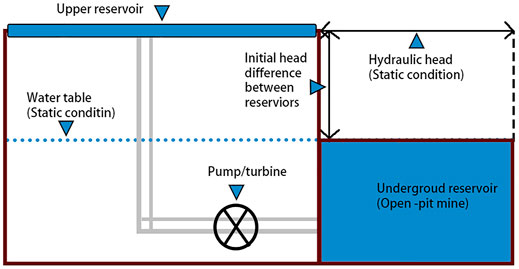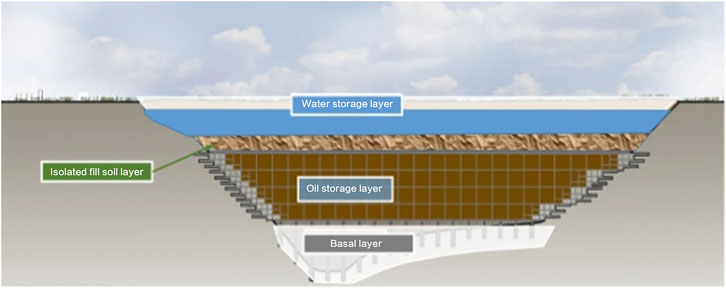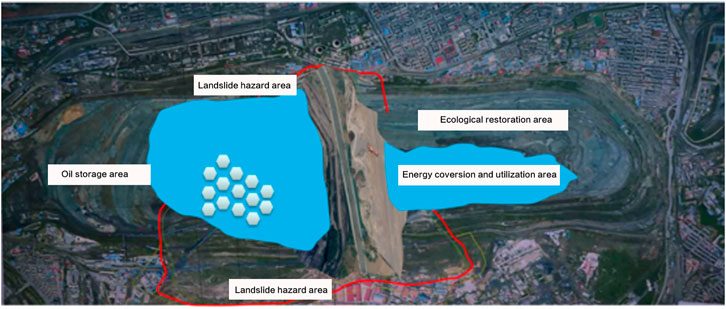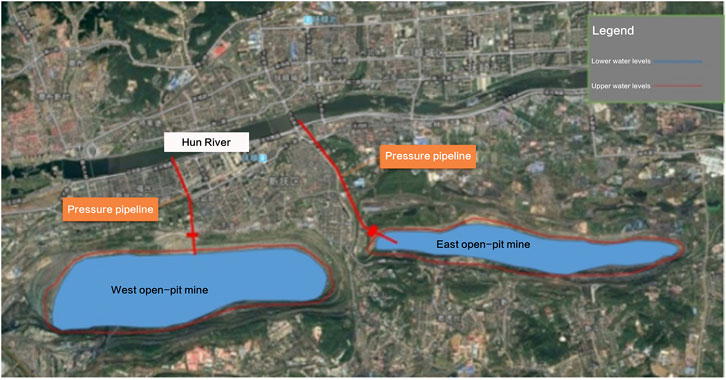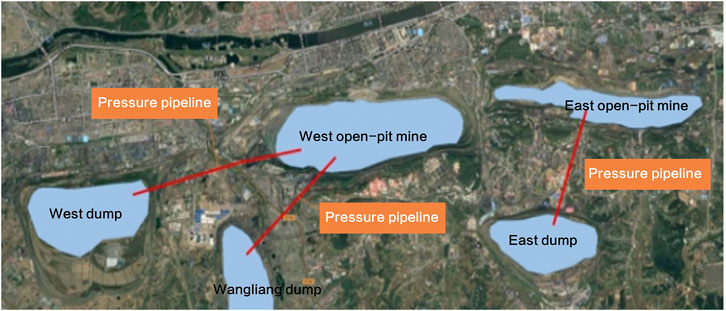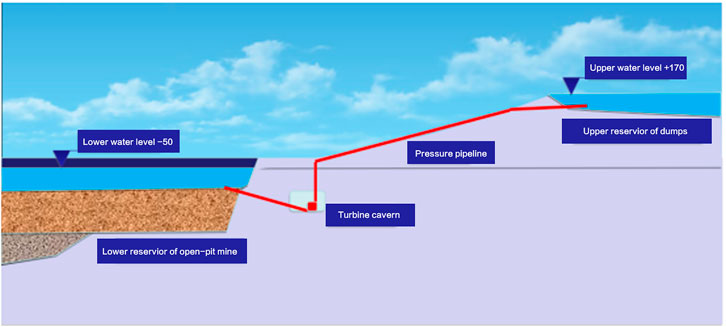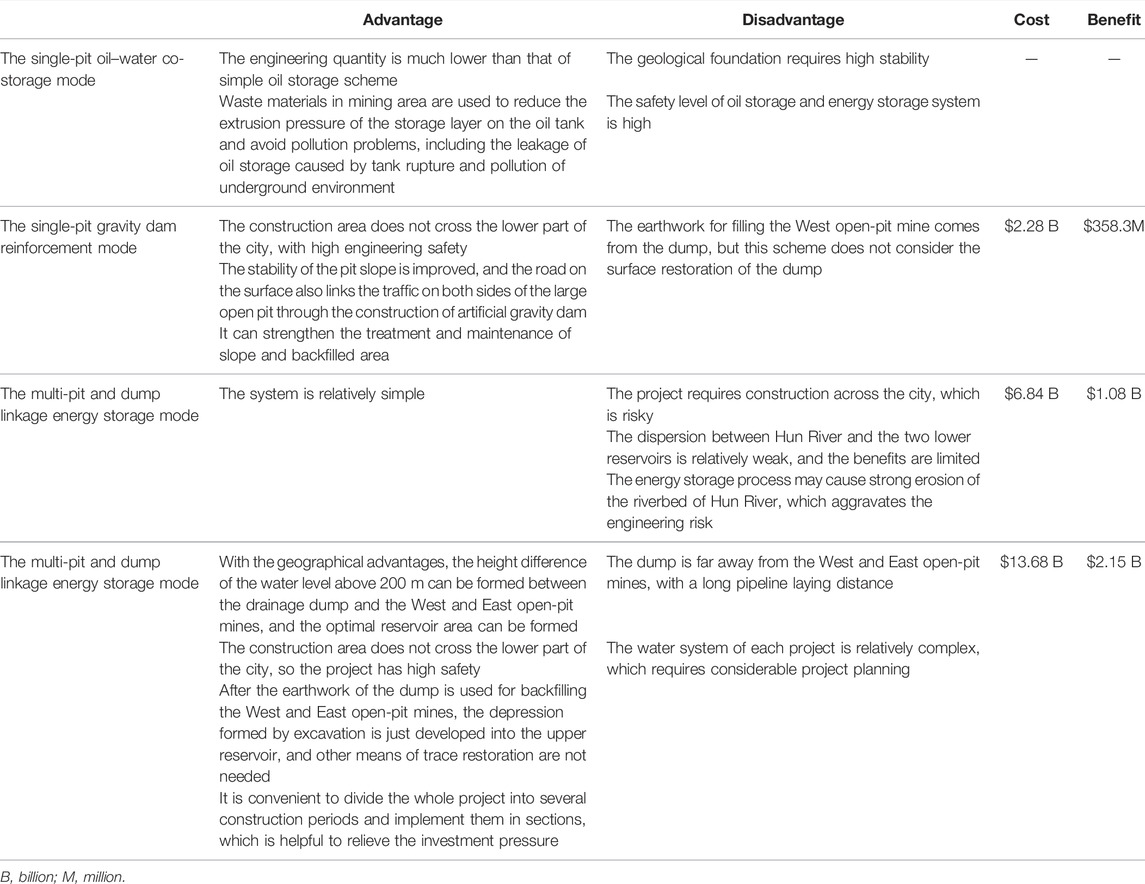- 1School of Architecture and Design, China University of Mining and Technology, Xuzhou, China
- 2School of Electrical and Power Engineering, China University of Mining and Technology, Xuzhou, China
Open-pit mining is one of the main exploiting methods for solid mineral resources. After more than 100 years of high-intensity development, there are a large number of abandoned open-pit mines and related mining relics in the world. The reconstruction of Pumped Hydraulic Energy Storage systems (PHES) from abandoned open-pit mines is an effective utilization mode of the abandoned underground space in recent years. The project planning of PHES should consider not only the technical and economic feasibility of PHES power station but also a series of problems, such as comprehensive utilization of mine dump, slope treatment, industrial heritage and cultural inheritance, ecological environment restoration of mining area, and transformation and matching of nearby resource-exhausted cities. This constitutes a complex planning problem of pumped storage in abandoned open-pit mines. This paper takes Fushun open-pit mine, the second largest open-pit mine in the world, as the analysis object and abstracts a variety of application modes of pumped storage in abandoned open-pit mines with the model research method. On this basis, the modes abstracted such as the single-pit oil–water co-storage mode, single-pit gravity dam reinforcement mode, multi-pit linkage energy storage mode, and multi-pit and dump linkage energy storage mode are all carefully studied in this paper. A series of supporting integrated programs are proposed for each mode with regard to ecological restoration, multi-energy complementary, cultural tourism governance, etc. In addition, based on the PHES with abandoned open-pit mine, this paper also explores the sustainable development of resource-exhausted cities and the transmission of their core industries.
1 Introduction
In the context of increasingly serious environmental problems, energy is an important basis for the survival and development of human society, and vigorously developing renewable clean energy has become a top priority (Corbijn, 2017; Luo et al., 2018; Wang et al., 2020). Recognized as the most mature and economical peak-load regulating energy storage power source, Pumped Hydraulic Energy Storage systems (PHES) can well adapt to the load changes of power systems on the one hand and provide more peak-load regulating capacity, frequency regulating, and phase regulating for the power grid on the other hand, thus improving the utilization rate of new energy power sources (Li et al., 2018). As of 2019, 7% of PHES were installed in the US and 14% in Japan. The capacity of installed PHES in China is only about 1.7% (Zheng, 2018). In total, 34 PHES have been built with an installed capacity of 29,990 MW, and 26 PHES are under construction, with an installed capacity of 37,050 MW. As is clearly proposed in The 13th Five-Year Plan for Hydropower Development (2020), the scale of PHES will reach 100 million kilowatts by 2025 (available at http://www.nea.gov.cn/). However, with the construction of previous large-scale pumped storage sites and recommended sites, there are fewer and fewer pumped storage sites with good development conditions. Especially with the introduction of ecological protection red lines in provinces (regions), the selection of pumped storage sites has become increasingly difficult. Therefore, it is imperative to seek new sites and utilization modes for PHES.
With the adjustment of global energy structure and the exhaustion of coal resources, a large number of abandoned coal mines have been closed or have entered the transition stage of abandonment, which consequently creates a large number of abandoned open-pit mines (Yu, 2004; Gao, 2017; Yuan et al., 2018). Modern mining in Europe is well developed and has created a large number of closed/abandoned open-pit mines. In Ontario, Canada, for example, there are nearly 7,000 quarries and open-pit mines. China is rich in mineral resources, among which the output and reserves of coal resources rank first in the world. However, compared with foreign countries, which have mainly open-pit mining, China's coal mining is mainly well mining. Accordingly, the open-pit mines are relatively few and mainly distributed in Shanxi, Shaanxi, Inner Mongolia, Yunnan, Guizhou, Sichuan, and Northeast of China. As of the end of 2017, China had 439 working mines, of which nearly 20 had been closed and more than 30 were facing closure. The pits left by open-pit mines generally are usually large in space, with different depths and water sources, which are similar to the engineering layout of PHES. Therefore, using the space left by abandoned mines to construct PHES is not only an exploration of a new mode of PHES but also a product based on the two-way demand of power market and ecological environment restoration. On the one hand, the construction of PHES in the open-pit mine can help expand the range of selection sites of PHES and build a new energy micro-grid system, which makes the mining area from the industrial water and electricity consumers into a new energy power supply outlet. On the other hand, it can promote the recovery of the natural ecological environment of the mining area and drive the development of surrounding industries, realizing the transformation of waste into treasure and thus exploring a new path to build a resource-saving and environment-friendly society.
Since the 1970s, some foreign countries have put forward the idea of converting abandoned mines to PHES. The world's first semi-underground PHES with real significance is located in Nasford, Austria. Its upper reservoir is a group of artificial tunnels, and its lower reservoir is a natural lake (Seiwald, 2007). In 2018, Australia began building a 250 MW PHES in an abandoned gold mine, capable of generating more than half of the country's electricity needs (Blakers et al., 2017). In recent years, in order to meet the demand of peak regulation using renewable energy, many research institutions in Germany have also carried out research on underground PHES. It is planned to transform the forthcoming abandoned Prosper-Haniel coal mine into a 200 MW semi-underground PHES (Andre, 2018). However, the focus of relevant research and practice is still placed on the method of underground water storage and energy storage in mines. Instead, there is a great need to study the construction method for water storage and energy storage in goafs of abandoned coal mines. China's coal industry has taken an important position in the past decades, but due to excessive mining, the coal resources in the eastern region are gradually exhausted. Accordingly, the western region has gradually become the key area for coal resources. But coal mining has exacerbated water shortages in the west (Gu, 2014). In this case, Gu (2015) put forward a new idea, taking the mined-out area under the mine as a storage reservoir and connecting the coal pillar dam body together to form a composite dam body through artificial transformation, so as to build a distributed storage reservoir under the coal mine. Xie et al. (2015) also proposed the idea of integrating underground reservoirs and pumped storage to make the most of the vast underground space created during excavation to achieve a variety of goals, including water storage, storage power generation, and new energy development. However, China, as a country of well mining, seldom participates in the research and practice of open-pit mines. Therefore, this paper takes Fushun open-pit mine as an example to discuss different utilization modes of PHES of abandoned open-pit mines and proposes supporting integrated model management schemes of ecological restoration, multi-energy complementarity, and cultural tourism. It provides a new treatment mode for open-pit goafs and a model treatment mode for the construction of PHES in abandoned open-pit mines.
2 The General Situation of Fushun Open-Pit Mines
Fushun, a coal-fueled heavy industry city in Liaoning province, is home to the Fushun West open-pit mine, which is the world's second-largest open-pit mine. The west open-pit mine is located in the west of Fushun, the south of Hun River. The mine is 6.6 km long from east to west and 2 km wide from north to south, with a mining vertical depth of 388 m and a total area of 13.2 km2. In the meanwhile, Fushun is a unique city with many open-pit mines. The east open-pit mine is 6.0 km long from east to west and 1.5 km wide from north to south, covering an area of 9.0 km2. The soft tuff in the east and west open-pit mines is unevenly distributed in direction and tendency, which has a certain influence on slope stability.
The dump is a concentrated accumulation of mine waste, consisting of coal gangue, stripping material, fly ash, and other wastes. There are three main dump sites in Fushun: Wangliang Dump, East dump, and West dump, which are distributed around two open-pit mines. The stacking area and slope stability of dumps have polluted the air and groundwater in urban areas (Xiao et al., 2021a; Zhao et al., 2021), so ecological restoration is urgently needed.
The comprehensive management of Fushun open-pit mine is of great significance to the core of regional economic development and the construction of ecological civilization (Xiao et al., 2021a; Cao et al., 2021). What is more, it also plays an exemplary role in the world. Close to the central urban area, the Fushun mining area can be summarized as “one area, two pits, and three dump sites.” The impact on urban areas is up to 74 km2, equivalent to 53% of the urban area (see Figure 1). With a large area of geological disasters in Fushun and the short distance between the two open-pit mines and central urban area, Fushun open-pit mine has a heavy impact on the urban area, including most of the problems in open-pit mines. It is highly representative of resource-based cities, thus being suitable for model research.
3 The Working Principle of PHES in Abandoned Open-Pit Mines
The construction of PHES generally requires sufficient height difference, abundant water, and strong power grid (Pujades et al., 2021). Theoretically, the greater the difference between water and height is, the greater capacity the energy storage possesses. Compared with conventional PHES, the working principle of PHES of abandoned open-pit mines is basically the same. But the differences still exist and are shown as follows: PHES of abandoned open pits do not resort to dam construction by making use of natural river height difference. It can establish two reservoirs, natural or artificial. The high power can produce electricity when the reservoir has enough water power, and low water pump can pump water when it lacks enough power load. Thus, it converts electrical energy into potential energy and then potential energy into electrical energy in the next peak load (Pujades et al., 2017) (Figure 2). At the same time, the PHES of abandoned open pits also need to take responsibility for environmental restoration and geological disaster control. It is generally composed of upper reservoir, lower reservoir, workshop, and water-conveying system (Li et al., 2018; Fan et al., 2020; Shang and Pei, 2021).
4 Multi-Scene Utilization Mode of PHES in Abandoned Mine
According to the situation of Fushun abandoned open-pit mine, the PHES in Fushun can be divided into four modes, namely, the single-pit oil–water co-storage mode, single-pit gravity dam reinforcement mode, multi-pit linkage energy storage mode, and multi-pit and dump linkage energy storage mode. With the reform in PHES of abandoned open-pit mines, the abandoned open-pit mines can be converted from a “cost center” to a “welfare center” for continuous industry development through multi-energy complementarity, ecological restoration, and cultural tourism management scheme. At the same time, it is effective to ensure the safety of national energy security and industry.
4.1 The Single-Pit Oil–Water Co-Storage Mode
The single-pit oil–water co-storage mode mainly involves water and oil reservoirs in open pits, including water reservoirs, isolated filled soil layers, oil reservoirs, and base layers from top to bottom (as shown in Figure 3). The following aspects need to be considered in this mode: 1) The foundation of the abandoned open-pit mine should be solid enough. Owing to long-term mining, the geological conditions of the mine are unstable. In this case, the base layer needs to be reinforced by digging and compacting the waste in the mine area. At the same time, backfilling and pressing foot and other methods should be adopted to improve the stability of the slope, so as to provide a foundation for the upper layer to be arranged. 2) The oil storage area is provided with oil reservoirs layer, in which a plurality of oil tank components are arranged in parallel, and each oil tank component can include a plurality of spherical oil tanks (Cao et al., 2021). The tank assembly needs to be effectively protected. According to the principle of the connecting device, the oil tank is buried in stone. The vertical height of the upper surface of the spherical tank is 30–50 m from the inlet of the drain pipe. As well as storing water, it also prevents external forces from striking the tank assembly. 3) The water storage layer and the oil storage layer need to be isolated so as to protect the oil storage layer and prevent upper water penetration. The isolation fill consists of two layers of concrete and has a mixture of soil and stone between them. Sand and stones used for isolation require little desulfurization. The total thickness is 30–100 m, and the thickness of a single-layer concrete is 10–15 m.
4.1.1 Supporting Treatment Scheme
In terms of multi-energy complementarity, the petrochemical industry is combined with new energy sources in mining areas. The open pit can be separated into adjacent energy conversion areas and oil storage areas by artificial gravity dam. The water in the tank assembly can flow out of the main water pipe under the coupling principle and gravity to drive the turbine in the drainage pipe to generate electricity and provide green energy for the local power grid. The peak regulation function of PHES is used to build a diversified energy base. At the same time, the external oil can quickly flow into the tank assembly and be stored under the combination of its own gravity and the negative pressure suction formed by the natural outflow of water from the tank assembly, which reduces the energy consumption of oil transportation.
In terms of ecological restoration, the treatment and maintenance of mine bases, slopes, and dump sites should be strengthened by backfilling and other measures. The stability of the base and bottom of the oil–water co-storage mode is urgently required. Accordingly, the basement of open-pit mine needs to be backfilled with tailings or waste rock and other materials to the bottom of the pit. These waste materials mainly come from the dump materials around the west and east open-pit mines. In Fushun open-pit mines, the comprehensive treatment of backfilling foot and water storage into the lake is mainly used to improve the stability of the basement and slope. The north side of the West open pit in Fushun is an anti-dip stratiform slope, which has a gentle upward slope and a steep downward slope angle. In order to improve the stability of the lower half of the slope, tailings or waste rock and other materials can be used to backfill the bottom of the pit as a whole, and the width of the transition step can be determined consequently. There are many buildings and dense population around the mining boundary, especially in the northeast of Fushun. Therefore, local slope cutting is necessary to strengthen the stability of the eastern slope. At the same time, the annual drainage project should be abandoned; instead, artificial rainfall and the fourth alluvial layer are to be relied on to fill the mine with water (Wang et al., 2021). The basement backfilling can realize land reuse of the dump by using the surrounding dumps' stacked waste. For the subsequent surface remediation of the dump, vegetation restoration suitable for the local climate should be selected after the deformation is stabilized, mainly including grassland and shrub restoration.
In terms of cultural tourism, the water storage layer of the reservoir can improve the climate and water supply conditions of the nearby area by regulating local temperature and precipitation, which promotes the development of urban health and art industry. Relying on the environmental effects of the central forest park, it can foster urban health and leisure industries, change the current productive capacity of industrial land, and integrate the development of industrial art and leisure atmosphere, thus creating a wide range of leisure life in the city.
4.1.2 Benefit Analysis
Environmentally, the land use of the dump can be changed after backfilling, which solves a series of pollution problems in the surrounding environment of abandoned open mines and improves the stability of the base and slope of the pit. At the same time, the surface landscape will form a surface pattern of lakes, forest, and mountains coexisting after the targeted surface restoration, which would in turn enrich the surface landscape.
In terms of economy, according to Fushun's development strategy, the petroleum industry is one of the pillar industries of Fushun and the key to the transformation of the city's industrial structure. According to this model, oil is stored in the lower part of the open pit and water in the upper part, making the open pit not only a huge oil storage tank but also a battery. With the adoption of the co-storage model, the entire open-pit space can generate revenue separately, extending the benefits of the project beyond a single energy storage project, which also promotes the diversification of oil sources. The single-pit oil–water co-storage mode can be applied to the single-pit gravity dam reinforcement mode, multi-pit linkage energy storage mode, and multi-pit and dump linkage energy storage mode, which provides a multi-energy storage mode for PHES. Therefore, the costs and benefits of single-pit oil and water co-storage scheme are not to be calculated separately.
4.2 The Single-Pit Gravity Dam Reinforcement Mode
The core engineering of single-pit gravity dam reinforcement mode is the potential energy difference between artificial gravity dam and two storage containers in an open-pit mine. Artificial gravity dam separates the open-pit mine into adjacent energy conversion and utilization area and oil storage area. In the energy conversion and utilization area, one end of the pipe is connected to the outlet of the pump, and the other end is connected to the oil storage area through the artificial gravity dam (Figure 4). When electrical energy is abundant in the area, water resources are transferred from the low place (energy conversion and utilization area) to the high place (upper part of oil storage area) through the pumping station, converting electrical energy into potential energy which in turn is to be stored in the oil storage area, thus achieving energy conversion and various forms of storage. When there is a lack of electric energy in the area, the drainage pipe is opened, and the water stored in the upper space of the oil storage area enters the drainage pipe from the water inlet, flows out from the outlet to the energy conversion and utilization area, converts the potential energy of water resources into electric energy, and feeds back to the power grid through the hydraulic generator set (Cao et al., 2021) (Figure5).
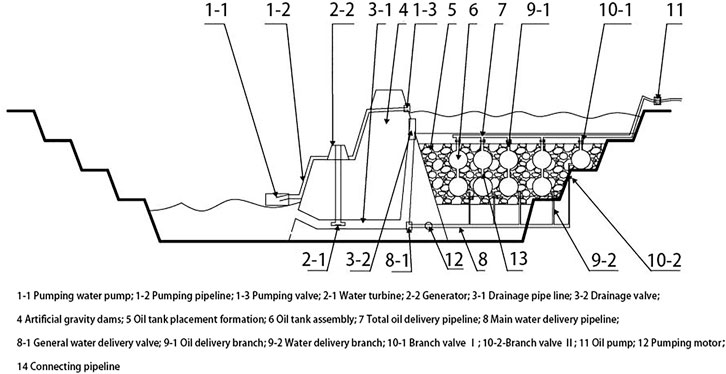
FIGURE 5. Cross section of PHES with gravity dam reinforcement mode in West open-pit mine (redrawn from Cao).
4.2.1 Supporting Treatment Scheme
In terms of multi-energy complementarity, the stability of the surrounding rocks is a prerequisite and a decisive factor for PHES of abandoned open-pit mines, which can ensure the air tightness of the underground space (Bian et al., 2021). The slope surface of Fushun West and East open pits is highly weathered, with the surface soil deficient and water holding capacity weak. Therefore, it cannot undergo short-term natural ecological restoration. The deformation of the north and south sides of the pit is basically controlled by the reinforcement of the gravity dam, the pressing foot project of the north and south sides, and the local backfilling in the west. Subsequently, some treating projects can be carried out in the north slope deformation area, including slope cutting reinforcement, slope surface protection, and vegetation planting, to control further deformation of the north side of the mining pit, which provides a good foundation for construction (Li et al., 2018).
In terms of cultural tourism, the model needs to control the sliding deformation of the south slope, by comprehensive treatment of backfilling foot and water storage, and ensure the stability of the reservoir and surrounding terrain. This will provide a good foundation for subsequent development of cultural tourism. When an artificial gravity dam is built in Fushun West open-pit mine, the average drop of upper and lower reservoirs is about 200m, which will expose a large area of the stratum profile of the upper and lower reservoirs and the surrounding exposed strata. It can be used as a good place for students of mining, geology, and other professional colleges to conduct in situ learning and practice. Measures should be taken to restore the mining landscape by protecting the existing strata, structural phenomena, fossils, etc., and combine the existing coal museum with the amber museum. Great efforts should be made to comprehensively develop industrial tourism around Fushun and promote the history of Fushun mining civilization. At the same time, according to the direction of the slope, the side of the wider mining pit is used to build commercial funeral grounds, large outdoor recreation facilities, and physical training bases, which can effectively save urban land resources and construction costs.
4.2.2 Benefit Analysis
In terms of transportation, as the stability of the slope of the open-pit mine on both sides is improved, the traffic on both sides of the open-pit mine is well connected. The two ends of the artificial gravity dam are connected with the slope of the mine, and the surface at both ends is at the same height as the corresponding slope surface. The top width of the artificial gravity dam is 20–50 m, and four to eight reinforced pavements are laid according to the demand of the traffic volume on both sides of the open-pit mine.
Environmentally, the benefit is mainly reflected in the repair of the slope. The stability of the slope can be greatly improved by the backfilling of earthwork. At the same time, backfilling also solves the problem of waste disposal and alleviates the pollution of the mine.
In terms of economy, the plan enhances crude oil storage and pumping storage. The construction of a pit oil storage project is a national strategic investment, and it is impossible to exactly predict the potential profits due to the fluctuation of international crude oil. In addition to ensuring the stability of electric power supply in the region, the abandoned pumped-storage power station also needs to undergo environmental restoration and geological disaster control. The benefits of environmental investment in each mode are sustainable for cities and residents and can be partly reflected through the improvement of local climate such as temperature and precipitation. Therefore, the environmental benefits cannot be calculated, either. PHES supplies power at peak and pumps water at low peak. The capacity of pumped storage is related to the water storage capacity and momentum of the open pit. When calculating the cost of power station, this paper refers to the standard of the total construction cost [EPC (EPC includes the core Project Engineering, Procurement and Construction cost) price] of 250 MW Kidston PHES, which is estimated to be $1.9 million/MW of installed capacity. The calculation formulas of power generation of PHES are shown in Eqs 1, 2.
where E denotes power generation;
Based on this, the installed capacity of different modes of PHES of Fushun abandoned open pits is calculated (Han et al., 2020). According to the peak–valley electricity price of Northeast power grid, the daily utilization time is determined to be 7.5 h; the electricity price at the valley is $0.055/kWh, and that at the peak is $ 0.164/kWh. The single-pit gravity dam reinforcement mode only calculates the cost and benefit of constructing an artificial gravity dam in the West open-pit mine, with the installed capacity of 1,200 MW. The cost of this mode is about $2.28 billion, and the annual income is $358.3 million. It greatly promotes development of the local economy and is conducive to the transformation of resource-exhausted cities.
4.3 The Multi-Pit Linkage Energy Storage Mode
The multi-pit linkage energy storage mode is relatively dependent on the engineering environment, requiring sufficient height difference and a relatively close distance between the open-pit mines and the reservoirs. Implementation of this mode depends on the construction of upper and lower reservoirs, including the availability of nearby reservoirs or lakes matching their storage volumes. The West and East open-pit mines are about 3 km away from Hun River, forming a certain height difference between Hun River and the West and East open-pit mines. Accordingly, the Hun River can be taken as an upper reservoir. Therefore, the plan is to set Hun River as the upper reservoir and transform the West and East open-pit mines into the lower reservoir so as to create a PHES (as shown in Figure 6).
4.3.1 Supporting Treatment Scheme
In terms of multi-energy complementarity, a large-scale distributed intelligent energy storage power generation system is to be built through the parallel pumping storage peak-regulating system of several mines with goafs. This makes up for the insufficient peak-regulating capacity of the deficient power grid.
In terms of ecological restoration, water circulation is the guarantee of water source and quality and is also an important factor for the later use of PHES (Pujades et al., 2016). During the water cycle of PHES, it is fairly necessary for the reservoirs to maintain an appropriate water level to avoid overflow, water shortages, or over-exploitation, which can lead to large groundwater levels. Water quality also affects the water cycle and the stability of surrounding rocks (Pujades et al., 2017). Hun River flows through several cities in Liaoning Province, where traditional heavy industry is relatively developed. Besides, this river has basically become the main channel for urban wastewater discharge along the coast. Therefore, more attention needs to be paid to the water quality of the Hun River. It can effectively prevent equipment of PHES from being damaged by contaminated groundwater. Sedimentation, filtration, biochemistry, and hydration are required to ensure the water quality of the reservoir.
In terms of cultural tourism, an ecological exhibition park and a wetland park can be built on the south side of Hun River, which can connect the upper and lower reservoirs, protect the underground pressure steel pipe pipeline, and provide a new place for teenagers and citizens to relax and learn. An ecological exhibition park is a demonstration base of environmental protection buildings, which can adopt the integrated development mode of leisure and entertainment display. An ecological wetland park makes full use of the current water body and restores and enriches the local biological ecological chain based on comprehensive ecological management so as to ultimately establish a Fushun urban ecological protection zone.
4.3.2 Benefit Analysis
In terms of transportation, the plan can enhance communication between the north and the south, improve the layout of Fushun open-pit mine around roads, railways, and other transportation, and promote the advantages of Fushun transportation. Fushun's main road transportation system is concentrated in the north of Hun River. Due to long-term coal mining, the density of road transportation network in the south of Hun River is far from meeting the needs of urban development. The urban transportation of Fushun can be improved through multi-pit linkage energy storage mode.
In terms of environment, the mode is mainly embodied in the sewage disposal and the stability of the slope. Similar to mine artificial gravity dam reinforcement mode, this mode needs to backfill earthwork mines and solve the problems of slope landslide. The multi-pit linkage energy storage mode will set Hun River as the upper reservoir, and the water quality of the Hun River is affected by the industry and residents around. Compared with other modes, this scheme has higher requirements for water quality control, avoiding the damage of polluted groundwater to equipment of PHES, and realizing the upgrading of industrial structure in the process of pollution control. By adjusting the industrial structure, the pollution to the river can be fundamentally reduced.
In terms of economy, the multi-pit linkage energy storage mode only calculates the cost and benefit of PHES with Hun River as the upper reservoir and West open-pit mine as the lower reservoir, with an installed capacity of 3,600 MW. The cost of this mode is about $6.84 billion, with an annual income of $1.08 billion. Compared with the single-pit gravity dam reinforcement mode, the project cost is higher. At the same time this mode has a certain influence on the urban traffic: with a large number of urban constructions between the upper and lower reservoirs, the implementation of this mode needs to be carried out through the city, including on-site construction drilling platform and distribution equipment transportation. This will inevitably exert certain impact on the city traffic and life.
4.4 The Multi-Pit and Dump Linkage Energy Storage Mode
The terrain of the surrounding dump is higher than that of the open-pit mine. By taking advantage of the natural geographical advantages, the difference of water level and height between the dump and the west and east open-pit mines can be more than 200 m, which facilitates construction. In the multi-pit and dump linkage energy storage mode, both west and east open-pit mines are transformed into lower reservoirs, and the dumps are set as the upper reservoirs (Figure 7).
The multi-pit and dump linkage energy storage mode is similar to the multi-pit linkage energy storage mode in that they both need to have certain height difference between the upper and lower reservoirs. Contrarily, by making use of the geographical advantage of the drainage field, the former can form the largest water level decline and the best reservoir area, thus giving full play to the advantages of crude oil reserves and pumped storage more easily. However, in this case, with the long distance between the upper and lower reservoirs, the laying distance of the pressure steel pipe is long correspondingly, which pushes up the engineering quantity and cost. This should also be considered in the implementation of the mode (Figure 8).
4.4.1 Supporting Treatment Scheme
In terms of multi-energy complementarity, this scheme can be combined with clean energy, such as solar energy, wind energy, and other clean energies. To be specific, a water photovoltaic system should be constructed to combine photovoltaic power stations and PHES into the power supply so as to participate in peak regulation. When the output of the daytime photovoltaic power station is greater than 0 and bears the load of the power grid, the PHES can reduce the output in the corresponding time period, and the reservoir reserves more water energy. At night, PHES is used as the main power station to compensate for power shortages caused by nighttime photovoltaic power generation.
In terms of multi-energy complementarity, the pressure foot measures and underground storage in the west and east open pits require a lot of earthwork to support the dump. The earthwork from the dump is diverted to the backfill in the west and east open pits. The depressions created by the excavation can be developed into upper reservoirs, which also reduces the risk of landslides caused by rainwater accumulation. The difficulty in the subsequent construction of the upper storage of the dump is to prevent the leakage caused by the settlement and deformation of the backfill earth and rock on the south side of the reservoir basin. Therefore, it is necessary to carry out the technical research on the construction of artificial lake on the backfill foundation and adopt impermeable materials and corresponding treatment technology. At the same time, coal mining reclaimed years shall be reformed to establish an ecological restoration demonstration project, the integration of aquaculture and aquatic plant, and the construction of PHES in the abandoned mines. The soil pollution in the dump site is relatively serious. Therefore, it is necessary to change the original single step into the terrace slope. By covering the site with out-soil or adopting oil shale semi-coke material, the soil condition can be improved. Meanwhile, vegetation with soil fixation, purification, afforestation, and medicinal values should be planted (Xiao et al., 2021b). In addition, more efforts should be made to promote the intelligent management and maintenance of the abandoned mines for environmental information and unmanned information supervision, including remote monitoring, automatic analysis, and early warning.
In terms of cultural tourism, the mode is to excavate the west and east open-pit mines, dump sites, and existing landscapes to form a landscape with distinct local characteristics. At the same time, it creates the life memory experience section, the mine industry exhibition section, the ecological culture leisure, and industrial scientific development section, to improve the ecological benefit of the area around the original industrial facilities. And by integrating the upper and lower reservoirs into the ecological corridor, a unique greenway landscape can be created, which highlights the relationship between the landscape and the history of the city.
4.4.2 Benefit Analysis
In terms of the environment, the nearby dump can provide earthwork for gravity dams; after backfilling, the depressions formed by the excavation would be developed into the upper reservoir, requiring no other treatments.
In terms of economy, the multi-pit and dump linkage energy storage mode only calculates the cost and benefit of PHES with the East dump as the upper reservoir and the West open-pit mine as the lower reservoir, with an installed capacity of 7,200 MW. The cost of this mode is about $13.68 billion, and the annual income is $2.15 billion. Compared with other modes, this mode costs a lot more, but it has “two pits and three sites,” which provides abundant space for sustained crude oil storage and pumped storage in the later stage. The whole project can be divided into several construction periods and implemented in stages, which helps ease the investment pressure. At the same time, it can use Chinese and Russian oil pipeline for storage; on this basis, a new system of refining and chemical industry can be established, which may greatly reduce the demand for oil and promote the sustainable development of metropolitan areas.
5 Discussion
The new model of comprehensive utilization of abandoned open pits is more complex than the traditional PHES and oil storage systems. In order to analyze the application conditions and risks of abandoned open-pit mines in a comprehensive, systematic, and accurate way, the advantages and disadvantages of each mode are compared and analyzed. The results are shown in Table 1. As can be seen from Table 1, the single-pit oil–water co-storage mode can make full use of the open-pit space and utilize mine waste to stabilize the base layer. Oil is stored in the lower part of the open pit and water in the upper part, making the pit not only a huge oil storage tank but also an accumulator of battery. However, the scheme puts forward high requirements on the stability and safety level of the oil storage system. The single-pit gravity dam reinforcement mode is a combination of oil reserves and pumped storage energy, which greatly improves slope stability. However, its disadvantages are obvious as well. Mine backfilling and gravity dam construction would involve a large amount of earth backfilling, and there is no repair of the surface of the dump. The multi-pit and dump linkage energy storage mode is relatively simple, but its engineering wiring goes through the city, increasing the risk of the construction. The dispersion between Hun River and the two lower reservoirs is relatively small, which inevitably limits the benefits. Compared with the first three modes, the multi-pit and dump linkage energy storage mode has a longer engineering period and relatively high cost, but it has the highest overall benefits in terms of transportation, environment, and economy. The scheme takes the dump as the upper reservoir, which can not only meet the demand of mine backfilling but also solve the environmental problems of the dump. Combined with the oil–water co-storage scheme, the establishment of PHES can greatly alleviate the oil demand and promote the sustainable development of metropolitan areas.
6 Conclusion
PHES of abandoned open-pit mines is a new research focus in the world, which helps to improve the mining environment and reduce geological disasters. In this sense, it is expected to become a new economic growth point for the development of renewable energy industry. Through the analysis and research of Fushun abandoned open-pit mines, the following tasks are completed in this paper: 1) The construction modes of four abandoned open-pit mines are described systematically. 2) Comprehensive management schemes for multi-energy complementarity, ecological restoration, and cultural tourism are proposed for different modes of abandoned open-pit mines. 3) With detailed analysis of the overall benefits in terms of transportation, environment, and economy of different modes and the comparison of advantages and disadvantages of various modes, the project initiators and designers for PHES of abandoned open pit both at home and abroad can select the construction mode in accordance with the actual geographical location and geological conditions. Through the case study of Fushun open-pit mines, this paper aims to provide a model for the reuse of abandoned open-pit mines internationally. In future studies, the following elements need to be considered from a systematic perspective: the application of renewable clean energy, the combined dispatching of smart power grid, and the changing trend of the supply ratio of traditional energy to new energy. This paper provides a valuable reference for giving full play to the utilization effect of PHES in abandoned open-pit mines.
Data Availability Statement
The original contributions presented in the study are included in the article/Supplementary Material, further inquiries can be directed to the corresponding author.
Author Contributions
PL contributed to conception and design of the study. PL, XH, and NC performed the statistical analysis. XH wrote the first draft of the manuscript. XH and NC calculated and analyzed the data. All authors contributed to manuscript revision and read and approved the submitted version.
Conflict of Interest
The authors declare that the research was conducted in the absence of any commercial or financial relationships that could be construed as a potential conflict of interest.
Publisher’s Note
All claims expressed in this article are solely those of the authors and do not necessarily represent those of their affiliated organizations or those of the publisher, the editors, and the reviewers. Any product that may be evaluated in this article, or claim that may be made by its manufacturer, is not guaranteed or endorsed by the publisher.
References
Alday, J. G., Zaldívar, P., Torroba-Balmori, P., Fernández-Santos, B., and Martínez-Ruiz, C. (2016). Natural forest Expansion on Reclaimed Coal Mines in Northern Spain: the Role of Native Shrubs as Suitable Microsites. Environ. Sci. Pollut. Res. 23, 13606–13616. doi:10.1007/s11356-015-5681-2
Andre, N. (2018). Proposed Underground Pumped Hydro Storage Power Plant at Prosper-Haniel Colliery in Bottrop–State of Play and Prospects. Mining Rep. Gluckauf 154, 214–223.
Bi, Z., Ding, D., and Zhang, X. (2005). Are View of the Utilization of Mined Area. Chin. J. Underground Space Eng. 1, 1080–1083.
Bian, Z., Zhou, Y., Zeng, C., Huang, J., Pu, H., and Axel, P. (2021). An Discussion of the Basic Problems for the Construction of Underground Pumped Storage Reservoir in Abandoned Coal Mines. J. China Coal Soc. 06, 1–12. doi:10.13225/j.cnki.jccs.YG21.0392
Blakers, A., Lu, B., and Stocks, M. (2017). 100% Renewable Electricity in Australia. Energy 133, 471–482.
Cao, S., Chen, S., Shang, T., and Yang, M. (2021). Comprehensive Utilization Model of Oil Storage and Energy Storage Og Abandoned Open- Pit. China Mining Mag. 06, 89–94. doi:10.12075/j.issn.1004-4051.2021.06.008
Corbijn, L. (2017). Benefits of Underground Pumped Hydro Storage (UPHS) in the Dutch Power System. Utrecht: Utrecht University. [dissertation/master's thesis].
Fan, J., Xie, H., Chen, J., Jiang, D., Li, C., and Ngaha Tiedeu, W. (2020). Preliminary Feasibility Analysis of a Hybrid Pumped-Hydro Energy Storage System Using Abandoned Coal Mine Goafs. Appl. Energ. 258, 114007. doi:10.1016/j.apenergy.2019.114007
Gao, W. (2017). Study and Demonstration on Reuse Mode of Abandoned Open Pit. [ Beijing (IL)]Beijing): China University of Geosciences. [ dissertation/master's thesis].
Gu, D. (2015). Theory Framework and Technological System of Coalmine Underground Reservoir. J. China Coal Soc. 40, 239–246. doi:10.13225/j.cnki.jccs.2014.1661
Gu, D. (2014). Water Resource protection and Utilization Engineering Technology of Coal Mining in “Energy Golden Triangle” Region. Coal Eng. 46, 34–37.
Han, Y., Zhang, X., and Wang, S. (2020). Study on Feasibility and Technical Economy of Abandoned Mine Pumped Storage in Multiple Scenarios. Mod. Business Trade Industry 41, 210–213. doi:10.19311/j.cnki.1672-3198.2020.11.103
Hydropower development (2020). Hydropower Development 13th Five-Year Plan 2016–2020. Availableat: http://www.nea.gov.cn/2016-11/29/c_135867663.htm (Accessed December 29, 2016).
Li, T., Gu, D., Li, J., Li, J., Dong, B., and Liu, S. (2018). Construction of Mine Water Pumped Storage Peak Regulating System Based on Abandoned Coal Mine Goaf. Coal Sci. Technology 46, 93–98. doi:10.13199/j.cnki.cst.2018.09.015
Luo, K., Shi, W., Cao, F., and Ma, X. (2018). Construction of Pumped Storage Power Station Using Abandoned Mine. Energy of China 40, 42–47.
Pujades, E., Orban, P., Bodeux, S., Erpicum, A., and Dassarguesa, P., (2017). Underground Pumped Storage Hydropower Plants Using Open Pit Mines: How Do Groundwater Exchanges Influence the Efficiency. Appl. Energ. 190, 135–146. doi:10.1016/j.apenergy.2016.12.093
Pujades, E., Poulain, A., Orban, P., Goderniaux, P., and Dassargues, A. (2021). The Impact of Hydrogeological Features on the Performance of Underground Pumped-Storage Hydropower (UPSH). Appl. Sciences-basel. 11, 1760. doi:10.3390/app11041760
Pujades, E., Willems, T., Bodeux, S., Orban, P., and Dassargues, A. (2016). Underground Pumped Storage Hydroelectricity Using Abandoned Works (Deep Mines or Open Pits) and the Impact on Groundwater Flow. Hydrogeology J. 24, 1531–1546. doi:10.1007/s10040-016-1413-z
Seiwald, S. (2007). Erweiterung Kraftwerk Naβfeld-Erhöhung Bockhartseed-Amm. Sterr Wasser-und Abfallwirtschaft. 7, 91–97. doi:10.1007/s00506-007-0105-2
Shang, D., and Pei, P. (2021). Analysis of Influencing Factors of Modification Potential of Abandoned Coal Mine into Pumped Storage Power Station. J. Energ. Resour. Technology-Transaction Asme 143, 112003. doi:10.1115/1.404960810.1115/1.4049608
Wang, F., Wang, D., and Yang, T. (2021). Stability Analysis and Treatment of Anti-dip Rock Slope Interbedded with Soft and Hard Rock in Fushun West Open-Pit Mine. Metal Mine 1-11. [2021-12-31].
Wang, L., Li, Z., Chen, J., Jiang, D., and Du, J. (2020). Preliminary Feasibility Study on Pumped Storage Reservoir in Goaf of Abandoned Coal Mine, 43. The Journal of Chongqing University, 47–54. doi:10.11835/j.issn.1000-582X.2019.261
Xiao, P., Feng, P., and Wang, X. (2021a). Stage Scheme of Comprehensive Treatment and Integration Utilization of Fushun West Open-Pit Mine. Open-pit mining Technol. 36, 6668. doi:10.13235/j.cnki.ltcm.2021.03.018
Xiao, P., Wang, X., Feng, P., and Zhang, Q. (2021b). Ecological Restoration Technology of Internal Dump in West Slope of Fushun West Open-Pit Mine. Opencast Mining Technology 36, 26–30. doi:10.13235/j.cnki.ltcm.2021.04.007
Xie, H., Hou, Z., and Gao, F. (2015). A New Technology of Pumped-Storage Power in Underground Coal Mine: Principles, Present Situation and Future. J. China Coal Soc. 40, 965–972. 10.13225/j.cnki.jccs.2015.0690.
Yu, J. (2004). Keep Away from Abandoned Mines. Contemp. Miners 12, 17. doi:10.1142/s0218348x04002409
Yuan, L., Jiang, Y., and Wang, K. (2018). Precision Exploitation an Dutilization of Closed/abandoned Mine Resources in China. J. China Coal Soc. 43, 14–20. doi:10.13225/j.cnki.jccs.2017.1803
Zhao, H., Shao, Z., and Du, H. (2021). Study on Optimization of Treatment Methods for Inclined Basement of Inner Dump Slope in Anticline Area of Openpit Mine. Coal Sci. Technology 49, 77–84.
Keywords: Fushun, abandoned open-pit mine, complexity planning model, PHES, model study
Citation: Luo P, Han X and Chen N (2022) Study on Complexity Planning Model of Pumped Storage in Abandoned Open-Pit Mine: A Case Study of Fushun Open-Pit Mine. Front. Earth Sci. 10:808371. doi: 10.3389/feart.2022.808371
Received: 03 November 2021; Accepted: 22 February 2022;
Published: 11 April 2022.
Edited by:
Jinyang Fan, Chongqing University, ChinaReviewed by:
Xu Nengxiong, China University of Geosciences, ChinaTarik Bahaj, Mohammed V University, Morocco
Copyright © 2022 Luo, Han and Chen. This is an open-access article distributed under the terms of the Creative Commons Attribution License (CC BY). The use, distribution or reproduction in other forums is permitted, provided the original author(s) and the copyright owner(s) are credited and that the original publication in this journal is cited, in accordance with accepted academic practice. No use, distribution or reproduction is permitted which does not comply with these terms.
*Correspondence: Pingjia Luo, bHVvcGluZ2ppYUBjdW10LmVkdS5jbg==
 Pingjia Luo
Pingjia Luo Xueqi Han
Xueqi Han Ning Chen
Ning Chen